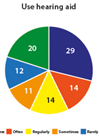Audiology features
Hearing, tinnitus and hyperacusis in the arts
Hearing loss, tinnitus and hyperacusis are discussed by David Baguley from the unique perspective of their depictions in literature, music, film and paintings. This article provides unusual and invaluable reflective opportunities for the patient-centred clinician! Audiologists and otologists understand hearing...
Tinnitus and music
Marc Fagelson discusses how not just hearing loss, but tinnitus and hyperacusis and impairments to an individual’s ability to process music can adversely affect one’s quality of life, as well as their overall interactions from a societal and personal perspective....
Music is noise
Marshall Chasin recaps what we know acoustically about music and noise, and discusses the potentially damaging levels of music, how temporary threshold shift (TTS) is not necessarily temporary and gives us some considerations for protective devices for musicians. Most of...
Teaching the art of cooking to a hearing impaired chef
Today catering is a hugely popular career choice for many people and there’s a new cookery competition or programme on our TV screens every week. But beyond the media glamour, the kitchen is a challenging and noisy working environment, in...
Taking a fresh look at otoacoustic emissions
So what has changed in four decades of OAEs? Do we now have all the answers? Have we reached our optimum recording ability? Professor Kemp explains what we know, what we don’t know and what’s to come. In the 40...
Otoacoustic emissions in the diagnostic test battery for hearing loss
So, they are great for screening, but how can otoacoustic emissions be integrated into the diagnostic test battery? Beth Prieve examines the role of diagnostic OAEs by asking three simple questions. Audiologists and otolaryngologists are familiar with otoacoustic emissions (OAEs)...
Canine hearing testing and the role of otoacoustic emission tests
Otoacoustic emissions testing is an accepted method of hearing testing in humans, but have you ever considered the situation in dogs? This article discusses deafness and hearing testing in dogs and the current role of OAE testing in this species....
Hidden hearing loss in humans
Awareness of cochlear synaptopathy (‘hidden hearing loss’) is growing. Chris Plack gives us an introduction to the condition, defining it and reviewing recent research in humans and animals with respect to noise exposure. The main cause of hearing loss is...
A binaural detection task that reveals deficits in listeners having ‘slight’ or ‘hidden’ hearing loss
The association of degraded binaural processing in adults with clinically defined ‘slight’ or ‘hidden’ high frequency hearing loss is of great interest to clinicians if it can be measured. Leslie R Bernstein and Constantine Trahiotis share their findings in measurements...
Developing outcome measures for research
There are challenges in developing outcomes measures; Professor Hall presents five top pointers for making rapid progress in developing outcome measures for research purposes. Anyone who has worked clinically with hearing loss will appreciate that every patient’s experience is personal....
Hearing aid outcomes in older adults: what and when to measure
What matters to older adults when purchasing a hearing aid? Larry Humes explores the domains that should be measured for this key group. This article identifies key domains of hearing aid outcome in older adults. Increasingly, third-party payers and private-pay...
The basis of the bargain: outcomes not inputs
There are international drivers focusing our attention on measuring outcomes; Anthony Hogan looks at the data to see how we are currently measuring up. Introduction A global paradigm change is impacting on the provision of disability services. At its heart,...

















